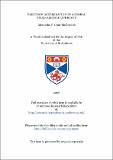Files in this item
Electron acceleration in auroral field-aligned currents
Item metadata
| dc.contributor.advisor | Wright, Andrew Nicholas | |
| dc.contributor.author | Cran-McGreehin, Alexandra P. | |
| dc.coverage.spatial | x, 221 p. | en_US |
| dc.date.accessioned | 2020-02-24T10:15:32Z | |
| dc.date.available | 2020-02-24T10:15:32Z | |
| dc.date.issued | 2006-11-30 | |
| dc.identifier.uri | https://hdl.handle.net/10023/19520 | |
| dc.description.abstract | Field-aligned currents at Earth's high latitudes are principally carried by accelerated electrons. Current densities, typically ~µAm⁻² at ionospheric altitudes, are sustained by parallel potential drops of ~100 - 1000 V. This Thesis presents Vlasov models of upward and downward current regions, where electrons are described via distribution functions. The ion density profile is fixed, and quasi-neutrality is invoked to solve numerically for the potential variation. In both cases, an ambipolar electric field traps ionospheric electrons. For downward currents, an energetic ionospheric electron beam emerges into the magnetosphere where it is accelerated around the B/n peak at altitudes of 500 - 6000 km to carry the current. The electric field maximises just Earthward of the B/n peak. The magnitude and altitude of the potential is found to depend solely on the equilibrium properties immediately above the B/n peak. An analytic non-linear current-voltage relation, analagous to the linear Knight relation for upward currents, is derived. Energetic magnetospheric electrons precipitate into the ionosphere to carry upward currents. The continuous potential variation is solved for current densities ~1 µAm⁻². Acceleration extends above the B/n peak for ~1 R[sub]E, and is increasingly concentrated at the peak for higher current densities. The presence of mirroring electrons is vital to the system, as they play a major role in satisfying quasi-neutrality, and support the majority of the parallel electric field. Ion outflow is a feature of both current regions, but is stronger and extends to lower altitudes for down¬ ward currents: this is presented as a possible explanation for observed lower-altitude acceleration in downward currents compared to upward currents. The effect of downward currents on E region number density is studied using an Alfven wave model of magnetosphere-ionosphere interaction, employing a height-integrated Pedersen conductivity. It is found that significant E region depletion and current broadening are more common on the nightside than on the dayside, and occur in ~ 10 - 100 s. | en_US |
| dc.language.iso | en | en_US |
| dc.publisher | University of St Andrews | |
| dc.title | Electron acceleration in auroral field-aligned currents | en_US |
| dc.type | Thesis | en_US |
| dc.contributor.sponsor | Carnegie Trust for the Universities of Scotland | en_US |
| dc.type.qualificationlevel | Doctoral | en_US |
| dc.type.qualificationname | PhD Doctor of Philosophy | en_US |
| dc.publisher.institution | The University of St Andrews | en_US |
This item appears in the following Collection(s)
Items in the St Andrews Research Repository are protected by copyright, with all rights reserved, unless otherwise indicated.

